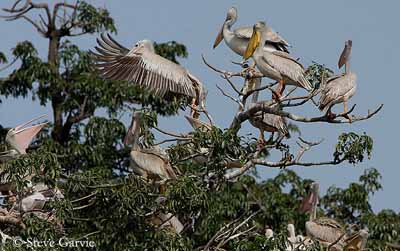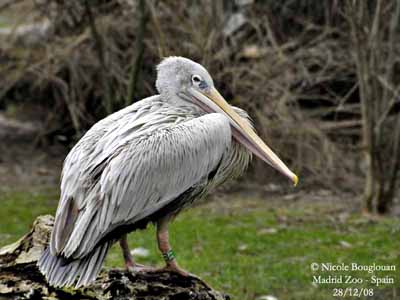
Pink-backed Pelican
Pelecanus rufescens
Pelecaniforme Order – Pelecanidae Family
BIOMETRICS:
Length: 125-132 cm
Wingspan: 265-290 cm
Weight: 4000-7000g
DESCRIPTION:
Pink-backed Pelican is one of the smallest of the 8 species, but is still a very large bird.
Fr: Pélican gris
All : Rötelpelikan
Esp: Pelícano Rosado
Ital: Pellicano rossiccio
Nd: Kleine Pelikaan
Russe: Пеликан африканский
Sd: Rosaryggad pelikan
Photographer:
Steve Garvie
RAINBIRDER Photo galleries
David Nowell
GALLERY
Text and pictures of the captive birds by Nicole Bouglouan
Sources:
HANDBOOK OF THE BIRDS OF THE WORLD vol 1 by Josep del Hoyo-Andrew Elliot-Jordi Sargatal - Lynx Edicions - ISBN: 8487334105
THE HANDBOOK OF BIRD IDENTIFICATION FOR EUROPE AND THE WESTERN PALEARCTIC by Mark Beaman, Steve Madge - C.Helm - ISBN: 0713639601
BIRDS OF THE GAMBIA AND SENEGAL by Clive Barlow and Tim Wacher – Helm Field guides – ISBN: 0713675497
BirdLife International (BirdLife International)

It has a pale greyish plumage, with pinkish back. Its dusky grey flight feathers contrast with the whitish wing coverts. Adult’s upperwing pattern shows pale greyish or pinkish grey coverts, contrasting with dark grey flight feathers. They have dark grey wingtips. Legs are variable in colour, ranging from grey to yellow or reddish orange, becoming pinkish red in breeding season. They have webbed feet.
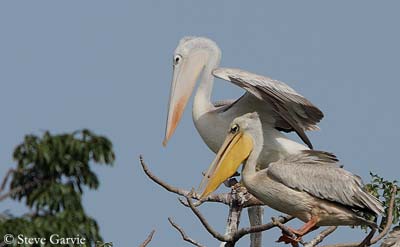
Bare parts are duller outside the breeding season. Adult has brighter pinkish yellow gular pouch, with still pale yellow bill. It has dark eyes, blackish lores and narrow area of pale pinkish skin around the eye, becoming yellow or orange when breeding, with blackish rear border.
Pink-backed Pelican has a broad area of feathering across forehead, ending in slightly concave line at bill base. We can see an indistinct short bushy crest on the nape.
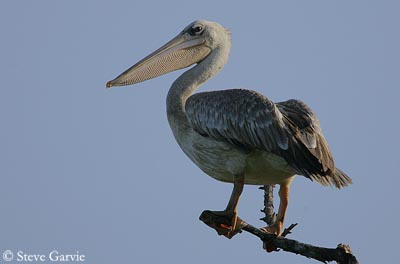
Female is slightly smaller than male.
Juvenile resembles adult in winter, but it has brownish-grey rather than greyish upperparts, very short crest on the nape, dark brown rather than grey tail, and darker grey secondary feathers.
When swimming or standing, the Pink-baked Pelican appears as the drabbest and greyest of the pelicans.
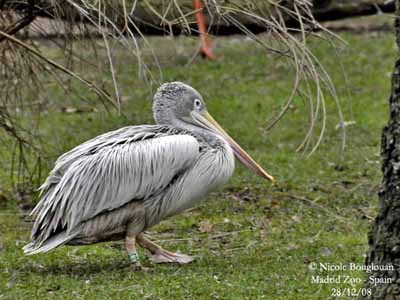
VOICE:
Pink-backed Pelican is generally silent away from colonies, only producing a few grunting and some hissing sounds.
HABITAT:
Pink-backed Pelican favours freshwater and saline lakes and lagoons, open water in marshes, mangrove creeks, sheltered coastal waters.
RANGE:
Pink-backed Pelican is rare but regular non breeding visitor to extreme S Egypt. It is vagrant to Morocco, Canary Islands and Israel.
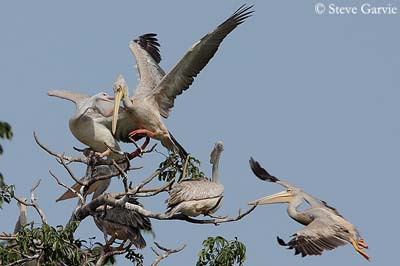
BEHAVIOUR:
Pink-backed Pelican’s main food is fish. It plunges its head under the surface and fills its pouch with fish and water. It shakes water out of the tip of the beak, and swallows the fish.
They generally fish in groups, forming a line to surround a shoal of fish. They plunge their heads at the same time, to fright and confuse the fish, and they scoop up in their pouches. Their beaks can hold up to 8 litres of water and fish.
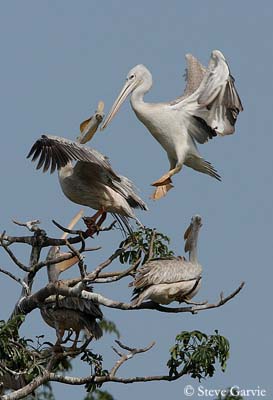
Pink-baked Pelican nests in trees, often near water, and also on sandy islands, in mangroves, and even close to humans. However, the trees die, due to the weight of the nests on their branches.
Pink-baked Pelican roosts on cliffs, coral reefs, sand dunes, and sometimes on piers or walls, in areas where food is abundant.
They are mostly dispersive, especially juveniles, but some regular movements are observed from North into sub-Saharan steppes for wet season. They perform local movements related to water conditions. They do not migrate long distances.
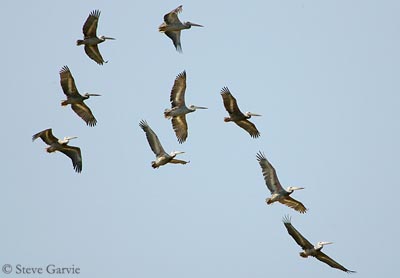
FLIGHT:
Pink-backed Pelican is one of the world’s largest flying birds. They take off with difficulties, but once they are in flight, they fly well with few wing beats, alternating with glides. They fly with their heads pulled back over their chests, rather than stretching out their necks.
When flying in flock, they use a slanting line as a formation. They take turns to relieve the leader when it tires.
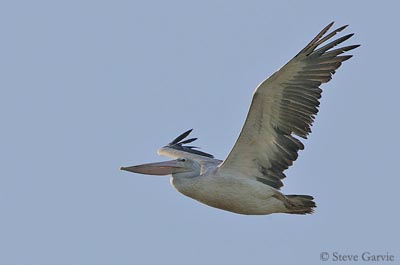
REPRODUCTION:
Pink-backed Pelican breeds all year round, mostly starting at the end of the rainy season. They nest in colonies from 20 to 500 pairs.
The large nest is made with sticks, in tree.
Female lays 2 to 3 large white eggs. Incubation lasts about 30 days. Young pelicans born naked, but a down coat is growing soon.
To feed, the chicks plunge their heads deep into the parental throat pouch, to take partially digested regurgitated fish.
Young have sexual maturity at 3 to 4 years. Relatively high mortality due to sibling aggression is often observed.
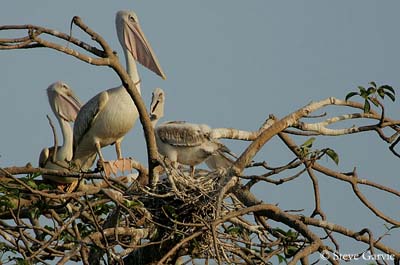
DIET:
Pink-backed Pelican feeds mostly on fish. They feed various food items with also small invertebrates and amphibians. They can move into drier areas to feed on locusts. Pink-baked Pelican may eat up to a kilogram of food in a day.
